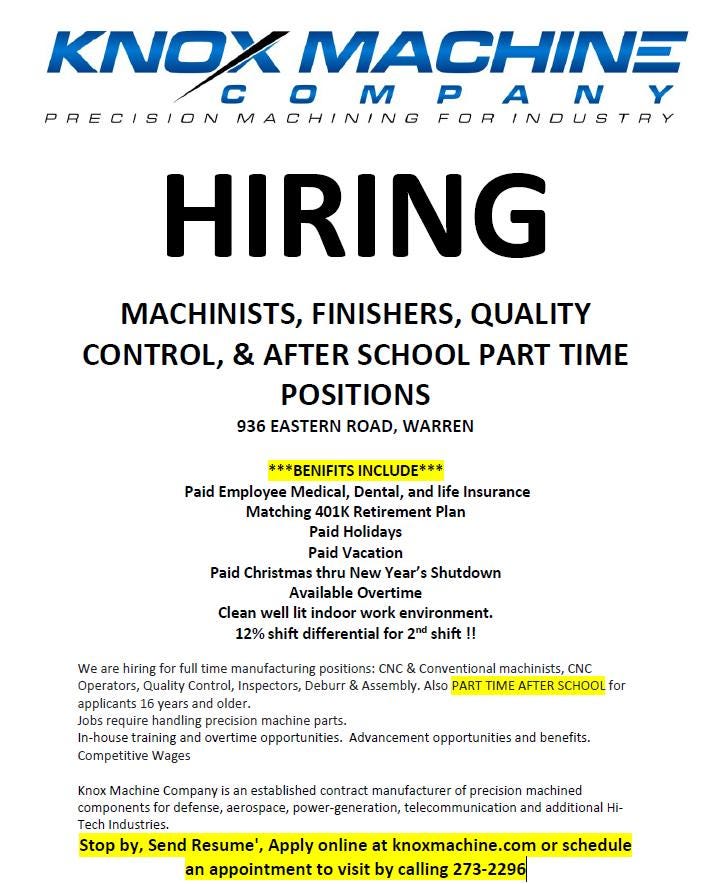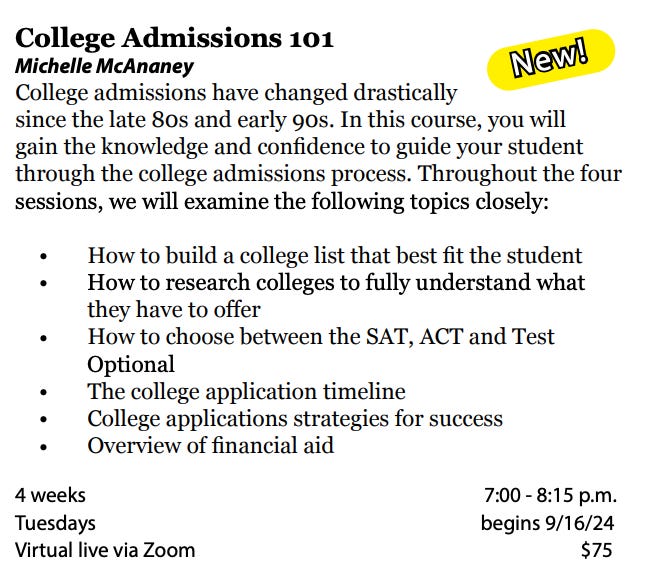Spotlight On…
Machine Tool Tech!
A little bit DWF (Direct to Work Force), a little bit WFD (Work Force Development), precision machining is a skilled trade that can put you on a fast track to the middle class without obtaining a postsecondary degree.
According to the OOH, the median salary is $53K annually, with 35K jobs opening up every year.
If you prefer to “book learn” it, you can–at MCST or Maine Community Colleges–but as the ad below demonstrates, you don’t have to; all you need to get started is a work ethic and some ambition.
One of our alums who graduated from the Precision Machine program at MCST could have gone right to work, but chose to continue his education at SMCC and work at Knox on the weekends. His skill set has become so valuable that he literally has a set of keys so that he can come and go as his time allows, working without supervision or oversight. He’s that good.
If you’re looking to transition to being a grown up immediately after graduating, it doesn’t get much better than this!
The College Spy Is Coming Home!
Michelle was our Director of Counseling for many years before she left the school counseling profession to become an Independent Educational Consultant. But, as the old saying goes, you can take the woman out of Maine, but you can’t take Maine out of the woman. She has wanted to come back for a while, so she recently took the bull by the horns and arranged to teach a course specifically for our community.
If you have a college bound kiddo, this will be must see TV! Please tell your friends and family–it’s a Zoom format so they can attend from literally anywhere on the planet, at a Maine based price point!
Link to register
NEACAC College Fairs Coming Up!
The New England Association of College Admissions Counselors (NEACAC) is bringing new technology to its College Fairs this fall!
https://www.strivescan.com/
Students can register for NEACAC fairs at www.StriveFair.com. Upon registration, StriveScan sends them a barcode via text message and email, which they show to reps at each fair. Registering for a barcode provides students with more information on each institution and allows them to connect with schools even after the event. There is no cost for students to register for a barcode.
You can go it alone on 9/17 from 6:30-8PM at USM or 9/18 at UMaine
OR
Join us on the big yellow bus traveling up to UMaine during the school day on 9/18.
We'll do the driving AND make sure you get fed!
Sign up here if you want to come with us!
SCOTUS AFFIRMATIVE ACTION RULING CONTINUES TO IMPACT ADMISSIONS
The scuttling of Affirmative Action called upon colleges to create an opportunity for kids within marginalized groups to identify themselves as such without directly asking anything about racial identity.
The prompt below is how the Common App has asked about race without actually asking:
Writing
Personal essay
Some students have a background, identity, interest, or talent that is so meaningful they believe their application would be incomplete without it. If this sounds like you, then please share your story.
How is it working? Certainly not very well at Brown…
From the Boston Globe:
Brown University sees a drop in Black, Hispanic new students following Supreme Court ruling that ended affirmative action
The percentage of first-year students from groups historically underrepresented in higher education plunged.
By Omar Mohammed and Hilary Burns Globe Staff.
PROVIDENCE — The percentage of new Black and Hispanic undergraduate students starting college at Brown University has nosedived a year after the Supreme Court ruled that higher educational institutions could not consider race in admissions, according to demographic figures released by the Ivy League institution on Friday.
In June 2023, the US Supreme Court, in a 6-3 decision, declared that universities were barred from taking into account a prospective student’s racial background when evaluating their application for admission, effectively ending race-based affirmative action. Experts had raised fears that the move could be detrimental to improving diversity in college campuses across the country.
On Friday, Brown University, which last year expressed disappointment with the court’s ruling but said would adhere to its instructions, revealed that of the 1,725 newfirst-year students, 9 percent identified as Black or African-American. This was 6 percentage points down from last year. Hispanic or Latinx students made up 10 percent of the new class, down 4 percentage points from 2023. Meanwhile, Asians constituted 33 percent of the incoming cohort, up 4 percentage points from a year ago. Those who declined to report their race or ethnicity increased to 7 percent, from last year’s 4 percent.”
Without someone explicitly telling students to choose that prompt for that purpose, kids clearly did not understand the importance or purpose of that question.
Common App launches 2024–2025 direct admissions program with 116 colleges and universities
Editor’s Note: ”Direct Admit” programs involve admitting students who have not applied for admission.
Arlington, VA – Today, Common App launched its direct admissions program for the 2024–2025 application season with 116 member colleges and universities. Beginning this month, first-generation and low and middle-income students who are college-interested will receive proactive admissions offers. New to the direct admissions program this year is the ability for students to regularly see, learn, and act on their offers directly in the application. Common App Direct Admissions also includes outreach and resources to counselors and families with students receiving direct admissions offers. Read on…
A Little “Light Reading”
What I’m reading this weekend
High Schoolers Need to Do Less So That They Can Do Better
To earn the distinction of valedictorian at Sunny Hills High School in Fullerton, Calif., a student must maintain a straight-A average and take at least 32 honors-level, semester-long classes. One weak “Gatsby” essay during these four years, one math test taken after an ankle sprain, one poorly conjugated verb can put a leak in the boat. And yet this past May, 39 of the 606 graduating seniors maintained the buoyancy to become valedictorians. Read on…
Will AI Make College Admissions and Advising Better — or Worse?
From The Chronicle of Higher Education
“Near the start of the summer, Zack Perkins and his technology company, CollegeVine, released a product-launch video that sought to show the promise of artificial intelligence in scaling up the work of admissions offices that give information to prospective students.
Perkins, dressed in a black T-shirt and jeans, announced “a new era of recruitment” by taking a call from “Sarah,” and asking her to introduce herself.
“I’m Sarah, an AI recruiter from Monza University,” the bot said in a vaguely seductive voice, representing a fictional college, created for demonstration purposes. “I meet prospective students, have amazing conversations about their interests and goals, and get them really excited about what we have to offer.” Sarah asked Perkins, posing as a student: What was most important to him in his college decision?” Read on…
Where Did All the Good Times Go?
Why risk-averse Gen Z is watching from the sidelines
They are familiar culprits: smartphones, social media, the decline of in-person social connection that began before, bloomed during, and held firm after the COVID-19 pandemic. A growing reserve of data and reporting raises the alarm about Gen Z’s age of discontent, always coming to the same conclusion: it doesn’t look good for the digital generation. As panic descends over what the Surgeon General has labeled a mental health emergency and, more recently, a loneliness epidemic, few accounts of Gen Z’s state of mind manage to foreground what I suspect is at the root of my generation’s distress: the shrinking of three-dimensional life, and with it, the loss of risk, adventure, and thrill. Read On…





